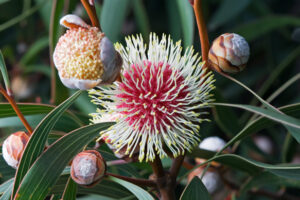Ooh la la! Winter design tips from France with an Australian twist
By Gabrielle Stannus
Whilst travelling in France earlier this year, I met with landscape designer and gardener Clare Obéron in Rennes, the capital city of Brittany in the country’s northwest, ostensibly to discuss how she designs her gardens to look good during winter. I was pleasantly surprised to hear, having travelled all the way from the so-called ‘antipodes’, that Australian varieties are high on rotation in many gardeners’ planting palettes in Brittany, including but not limited to lomandra!
Originally from England, Clare found herself in Brittany after moving to Paris to work as an architect where she met her future husband. “We wanted to get out of Paris at one point. We decided on Brittany as my husband was from Burgundy and my family was in the UK, so it was sort of a halfway stop. We ended up buying a huge ruin of a house and spent thirty years trying to do that up,” says Clare.
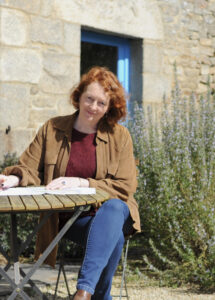
“I have always loved the winter garden. There are so many things you can use in the garden in winter. However, we are very lucky here because we are in an area where you can be outside pretty much all year round. You can work in the garden pretty much all year round, unless it is really wet.
“In Brittany, we have quite a temperate climate, so in the winter, there is still quite a lot of vegetation. I work a lot with foliage, using quite a lot of evergreen planting, some Mediterranean style plants, and some pittosporum. We do not have a lot of cold, so we can plant some quite borderline hardy things.”
Whilst Clare’s designs include built structures to provide shelter and comfort during the cooler months of the year, she is more interested in encouraging her clients to use the garden during those times. Clare’s landscape designs allow for views from the inside to the outside, so the garden is not revealed all at once from the indoors.
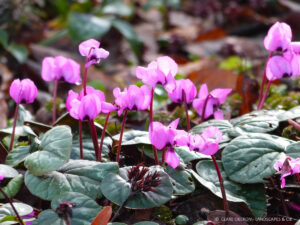
“I like to have a view on something which gives you that bit of colour in the winter. This may kind of disappear in the summer and be quite green or simple, but it gives you a focal point over the winter,” says Clare. She uses summer dormant cyclamens, such as the small-leaved Cyclamen coum which make for wonderful flowering carpets during the winter, and herbaceous perennials including hellebores, a reliable winter standard in many gardens.
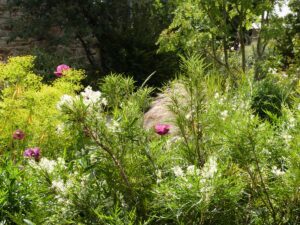

“I also like to have scented shrubs and other features which are a little way away from the house, to get people to go outside and to be in and to walk around the garden,” Clare continues. Having things that will entice you out because you want to go and have a look, such as snow drops (Galanthus spp.), achieves this. She likes to strategically place early and late winter flowering shrubs throughout her gardens, including Jasminum nudiflorum (Winter Jasmine) , Viburnum farreri (Farrer Viburnum), and Viburnum x burkwoodii (Burkwood’s Viburnum), so that her clients can enjoy both their scent and colour from up close and afar.

As Clare describes her planting palette, I feel like I am being transported home to Tasmania where similar exotic plants were used by European colonisers to create gardens to remind them of ‘home’. Clare then begins to tell me about the Australian native plants she uses, and local designers such as Michael McCoy and Fiona Brockhoff from whom she draws inspiration, the latter especially for her coastal gardens.
With a South African father, it is perhaps not surprising that Clare draws inspiration from the southern hemisphere. “In Brittany, I use a lot of plants from South Africa, as well as New Zealand and Australia. In the winter, you get a lot of that lovely texture with grasses,” says Clare of her use of South African species including Elegia, a genus of grass-like plants in the family Restionaceae.
Clare’s evergreen structural planting includes New Zealand’s carex-like Chionochloa rubra (Red Tussock Grass) with its bronze foliage, and our very own lomandra! “A lot of plants that we are now getting, like Lomandra longifolia ‘Tanika’ for example, were not available even three, four years ago but are now coming into France through specialist nurseries,” she explains.
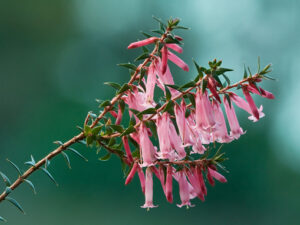
Clare also maintains winter interest in her gardens by using evergreen perennial species, including Australian trees and shrubs. She uses lomatia, including Lomatia tinctoria (Guitar Plant) as well as its South American ‘cousin’ L. ferruginea, in her gardens, and tells me that callistemons are quite popular in Brittany’s coastal gardens.
Clare also uses smaller, more compact eucalypts to provide structure and foliage interest throughout the year, including winter, such as the slower growing and ultimately shrub-like Eucalyptus pauciflora subsp. niphophila (Snow Gum). Clare says that eucalypts came into fashion in Brittany around twenty years ago, and that local designers, including herself, are well supplied through specialist nurseries such as Pépinières Botaniques Armoricaine. This nursery supplies over fifty eucalypt varieties locally! I really must visit it next time I am in France.
Other tips for a winter garden
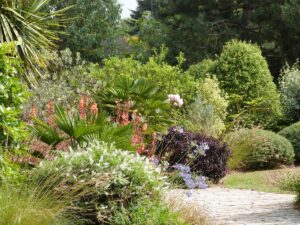
Clare recommends planting small plants, so plants can grow to the local conditions. “I think people come to me because of the planting, but they do not always understand what that really implies. I always used to plant very small when I started out twenty, thirty years ago. I would usually plant small plants and whips for trees, and they always got away really well. I had this client in Saint-Malo for whom we put in a big evergreen oak. I said to him when we did it, ‘I really do not want to do this. We are by the sea. It is going to get a lot of wind, even if it is well tied in’. And this oak has really suffered. If we had put something much smaller in, it would already be away now.”
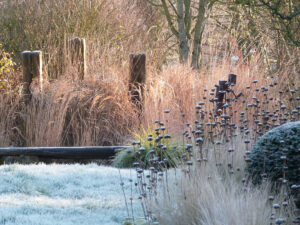
Clare selects hardscaping materials for use in her gardens for their durability over the wet Brittany winters: “We still use quite a bit of wood. I have often used chestnut, a locally available wood, just cut into sections to form simple block benches. If you are going to have a bench outside, install some paving underneath so that it can stay there, and you avoid getting muddy feet when sitting there.”
“I try to use natural stone whenever I can, including reclaimed stone and pavers. In Brittany, there is a lot of slate, so that is something we also use a lot in our gardens.
The biggest problem that we have is in parking areas, how to keep things draining so that we are not using too much hardscaping. Gravel needs to be maintained, but we are trying to do things differently. Instead of gravel, we quite often use what we call ‘terre-pierre’, which is a mix of earth and stone, seeded with grass.”
Best Brittany gardens to visit
Clare says that Brittany has many gardens of note that will interest Australian landscapers, with three of its most well-known including Le Jardin de Pellinec, Le Jardin Botanique at the Domaine du Kestellic, and Les Jardins de Kerdalo. Kerdalo is an iconic estate created by a Russian prince in the mid-20th century near Tréguier, on Brittany’s northern coast. Kerdalo is now owned by Christopher Louboutin, the fashion designer best known for his high-heel shoes, something I will never wear and certainly not practical for the garden! Being closed to the public during winter, I was unable to visit Kerdalo or the other gardens listed here at this time.

So, upon my return to Australia, I conducted a little research into Kerdalo, learning that our native species have found their way onto this estate too, as well as in Clare’s gardens. Kerdalo’s plant list features Australian species such as Acacia baileyana ‘Purpurea’, Acacia pravissima, Dodonea viscosa ‘Purpurea’, Eucalyptus pauciflora, Leptospermum lanigerum, Leptospermum lanigerum ‘Silver Sheen’, Lomatia myricoides, and Pandorea pandorana. Also included are Banksia integrifolia, Dicksonia antarctica, Drymis lanceolata and Olearia argophylla, although both Australia and Tasmania (bizarrely) are listed as their ‘countries of origin’ (French: Pays d’origine)! What Kerdalo’s horticulturists refer to as Drimys lanceolata is now called Tasmannia lanceolata or more commonly, Mountain Peppery, although its French name, Poivre de Tasmanie, has a certain ‘je ne sais quoi’!
These Australian evergreens are scattered throughout the various gardens at Kerdalo, so, I would think there is enough interest to provide viewing value to the public during the winter. However, perhaps there are not enough visiting tourists during that time to make it financially viable for Kerdalo to open its gates. I really must get there during the spring or summer next time I am in France!
My tips for local winter interest
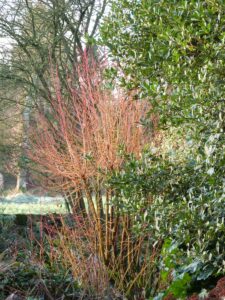
Natives
Check out the early flowering wattles that are available in your part of Australia. Acacia dealbata (Silver Wattle) grows profusely where I live in northern Tasmania, and it always puts a smile on my face when I see the first buds burst into bloom. A. dealbata starts flowering around July, as does A. pycnantha (Golden Wattle), Australia’s national floral emblem.

Who could go past the beautiful crimson flowers of Hakea laurina (Pincushion Hakea)? Admittedly this species is a little touchy down here in Tasmania but does well elsewhere on the ‘mainland’ in sandy sites reminiscent of its original habitat in the southern part of Western Australia. Flowering from March through to August, this hakea is a wintertime stunner.
One of my personal favourites is Epacris impressa (Native Heath), for its pop of winter colour, pink or white depending on local conditions.
Exotics
“Every garden is very individual. What I would do on the coast is not the same as what I would be doing in a country garden. However, I would certainly be using deciduous trees to provide structure and winter interest,” Clare tells me.
People would be forgiven for thinking that the appeal of many deciduous species is limited to their changing autumn foliage. Consider though the appeal of Acer palmatum ‘Sango Kaku’ (syn. ‘Senkaki’) (Coral Bark Maple) or Cornus sericea (Red Osier Dogwood), both of which possess vivid coloured bark that ‘sans foliage’ make for a real standout in the garden.

